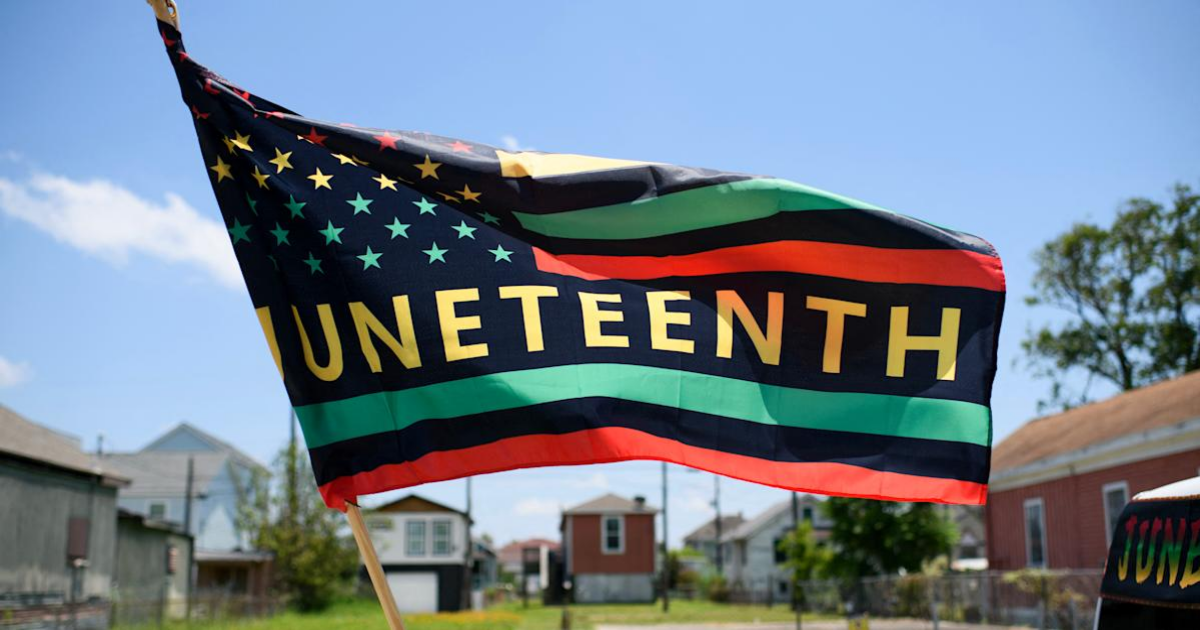June 19 marks Juneteenth, a holiday that commemorates the emancipation of enslaved people in the United States. It became a federal holiday in 2021 when then-President Joe Biden signed the Juneteenth National Independence Day Act into law. Now, across the country, many people have off from work and use Juneteenth to celebrate, reflect and educate themselves on the dark history of slavery in the U.S.
What is the history of Juneteenth? How is it celebrated?
Juneteenth commemorates June 19, 1865. That was when Union General Gordon Granger arrived in Galveston, Texas, and announced that over 250,000 enslaved people were free, more than two years after the Emancipation Proclamation was issued by President Abraham Lincoln and declared slaves in Confederate states were free. Originally celebrated by newly freed Black communities in Texas with religious services, barbecues and symbolic traditions like discarding clothing worn during enslavement, the holiday has since grown beyond Texas and the South.
People hold an African American flag as they watch the Harrisburg Juneteenth parade. (Paul Weaver/SOPA Images/LightRocket via Getty Images)
Though festivities resurfaced in Black communities during the 1960s Civil Rights Movement as a way to honor their legacy, the holiday — sometimes referred to by other names such as “Second Independence Day,” “Freedom Day,” “Emancipation Day” or “Black Fourth of July” — gained national attention once again during the 2020 Black Lives Matter movement. The movement inspired Congress and Biden to create an official federal holiday to honor Juneteenth the following year.
What do modern Juneteenth celebrations look like?
Modern Juneteenth festivities are vibrant and celebratory, and typically involve outdoor activities like cookouts and picnics. Large community events are also held: Last year, the White House hosted a concert on the South Lawn for Juneteenth and Black Music Month. This year, Juneteenth events across the country include things like film screenings, festivals, concerts and other community cultural events.
In an opinion piece for the Arizona Republic, Greg Moore wrote, “It’s a good time to find a community of people and celebrate the racial progress we’ve made over the last few decades…And given all the separation Black Americans have faced through history, it would be fitting to celebrate in a community gathering — the bigger, the better.”
People dance at an event to mark Juneteenth, which commemorates the end of slavery in Texas, over two years after the 1863 Emancipation Proclamation freed slaves elsewhere in the U.S., in Nashville, Tenn., June 19, 2024. (Reuters/Kevin Wurm)
Some people may prefer to use Juneteenth as a day of reflection, education and remembrance. That could include going to a museum, some of which are hosting special programs for the holiday on Black American history. The National Civil Rights Museum in Memphis, Tenn., is marking Juneteenth with free admission and educational activities for families.
This year, many Juneteenth events have been scaled back or canceled because companies and local governments are cutting funding for diversity, equity and inclusion (DEI) initiatives.
Does how you celebrate Juneteenth matter if you aren’t Black?
You can honor Juneteenth even if you are not Black, Karida Brown, a sociology professor at Emory University, told the Associated Press. Brown explained that the history of slavery in America is all of our history, and it’s important to recognize “the good, the bad, the ugly, the story of emancipation and freedom for your Black brothers and sisters under the Constitution of the law.”
Andrea Gant and her son attend an event to mark Juneteenth in Nashville, Tenn., June 19, 2024. (Reuters/Kevin Wurm)
However, Moore wrote in the Arizona Republic that it’s important not to let Juneteenth go the way of holidays like Cinco de Mayo, in which cultures are reduced to harmful stereotypes. He’s afraid Black culture can be “warped beyond recognition” during disrespectful celebrations. “There shouldn’t be any blackface or watermelon jokes,” he said.
What is the Juneteenth flag, and what does it represent?
While red, green and black are colors associated with Juneteenth — those are the colors of the pan-African flag, which represents the African diaspora and the unity of Black people — the Juneteenth flag is red, white and blue. It was created in 1997 by community organizer and activist Ben “Boston Ben” Haith in order to give the holiday a unifying symbol.
“For so long, our ancestors weren’t considered citizens of this country,” Haith said in an interview with Capital B. “But realistically, and technically, they were citizens. They just were deprived of being recognized as citizens. So I thought it was important that the colors portray red, white, and blue, which we see in the American flag.”
The star in the center stands for two things: Texas, where Juneteenth began, and, according to Haith, the white burst around the star symbolizes a new star being born — representing a new beginning for Black Americans. The red arc below it represents a horizon, signifying progress and hope for the future.
What’s open and closed on Juneteenth?
While Juneteenth is now a federal holiday, people employed in the private sector are not legally required to recognize or observe the holiday. In turn, privately owned shops, restaurants, grocery stores and other retail businesses will likely keep normal hours on the holiday unless they choose to honor the holiday in some way.
Most major banks, as well as the stock market, are closed on Juneteenth. So is the post office and other federal offices. Public schools and libraries are typically closed as well.





